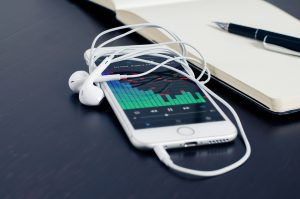July 20, 2018, by David Maidment
New technologies for hearing loss
Welcome to the July issue of the Hearing Matters blog by the Mild to Moderate Hearing Loss Group at the NIHR Nottingham Biomedical Research Centre. This month, we take a look at some of the latest listening technologies that are available for people living with hearing loss.
Hearing aids are effective
 Our research shows that hearing aids reduce negative consequences of hearing loss, improving an individual’s quality of life and listening abilities. However, despite being effective, the majority of people who would benefit from using hearing aids do not access them. People report that they often continue to experience listening difficulties when there is a lot of background noise. In addition, the stigma associated with hearing loss and hearing aids is another key barrier.
Our research shows that hearing aids reduce negative consequences of hearing loss, improving an individual’s quality of life and listening abilities. However, despite being effective, the majority of people who would benefit from using hearing aids do not access them. People report that they often continue to experience listening difficulties when there is a lot of background noise. In addition, the stigma associated with hearing loss and hearing aids is another key barrier.
Are smartphones the answer?
 Conventional hearing aids must be programmed by a trained audiologist using specialist equipment in the clinic. Hearing aid users can only make limited adjustments to the programmes to meet their individual listening and communication needs.
Conventional hearing aids must be programmed by a trained audiologist using specialist equipment in the clinic. Hearing aid users can only make limited adjustments to the programmes to meet their individual listening and communication needs.
In recent years there has been an increase in the availability of listening devices that connect to smartphones via Bluetooth. Smartphone-connected listening devices include:
Made-for-smartphone hearing aids, which are initially programmed by an audiologist, and are programmed to an individual’s specific hearing loss.
Personal sound amplification products (PSAPs) can be purchased online. They are not medical devices and, as such, are not programmed to an individual’s specific hearing loss. However PSAPs can offer different pre-sets for the user to choose from depending on the level of hearing loss.
Hearing aid applications (or apps). There are currently over 100 Smartphone hearing aid apps available to download for free from Apple or Google Play App stores. Some of these apps include hearing tests that allow the user to make adjustments. They can be used with either wired or wireless earphones.
Hearables are a type of wireless (or Bluetooth) earphone that provide additional features, such as activity tracking (e.g. heart rate, calories, and step count) and audio-streaming. They can make sound louder when used with a ‘hearing aid’ app.
Common to all of these devices is that they enable an individual to conveniently adjust their hearing programs in any listening environment via a smartphone app. But how accessible are smartphone technologies to the typical first-time hearing aid user age group? In the UK, the over-55 age group is experiencing the fastest year-on-year rise in Smartphone ownership, more than doubling from 19% in 2012, to 71% in 2017.
 Our research…
Our research…
In a recent online survey of over 100 adults living with hearing loss, we found that the majority of people (approximately 80%) were not aware that smartphone-connected listening devices even existed. However, all survey respondents reported that they would be ‘extremely interested’ in using a smartphone-connected listening device to manage their hearing loss.
In another study, we asked existing hearing aid users to trial a smartphone-connected listening device in their everyday lives for a period of two-weeks. Everyone who took part in the study told us that they liked the ability to personalise and adjust their own listening devices in order to improve their ability to hear and communicate in any situation. They also reported that this gave them a greater sense of control and empowerment, reduced stigma, and resulted in less frustration, greater participation and more device use.
Following on from this work, we have a number of other projects that are currently underway or in development, which will focus on the benefits of smartphone-connected listening devices and how they can be best incorporated into NHS Audiology Services. Our ultimate aim is to explore whether smartphone-connected listening devices can increase the likelihood that people will more successfully manage their hearing loss.
Written by: Dr David Maidment, Research Fellow, Mild to Moderate Hearing Loss Research Team, NIHR Nottingham Biomedical Research Centre


Very interesting article. I think you may be right about smartphones and hearing aids. I usually get a “Wow! That’s cool.” From people when I show them the app on my phone. It gives me so much more control and means I don’t have to fiddle with buttons on my hearing aids. I do have to explain why I am using my phone in some places where people have asked for them to be switched off. I keep the sound off and rely on vibrate to alert me when necessary. Please do keep up the good work. Research is so important. Am loving the blog, too.
Thank you for your comment, Kathleen. I’m glad that you enjoyed this months blog. It’s great to hear about your experiences with smartphone-controlled hearing aids. They are very similar to what was reported by our participants in our original study: https://starkeypro.com/innovations/Volume7-Issue3/index.html?page=26.
I’ve just updated the blog with the results from our online survey, published in the British Academy of Audiology Spring 2018 Magazine: https://tinyurl.com/y8awu6ys